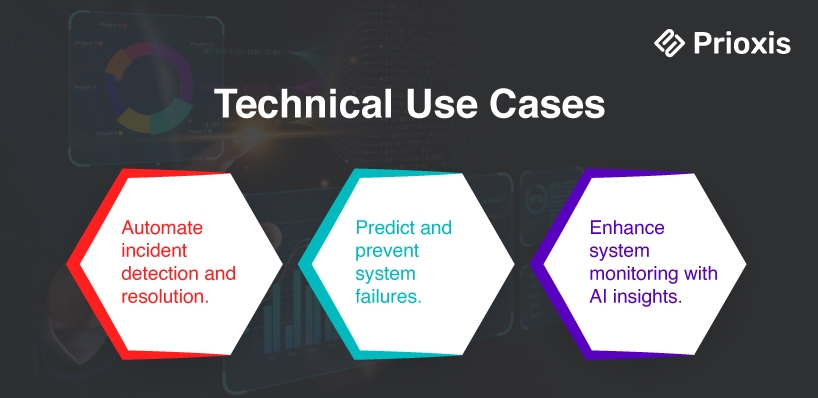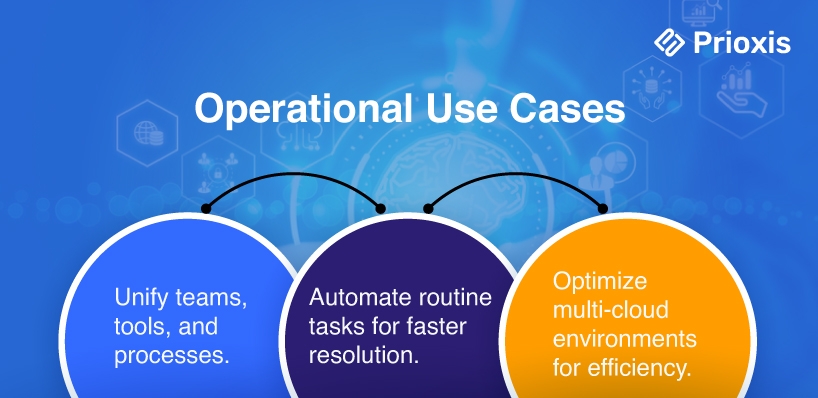What is AIOps? A Comprehensive Guide
 Admin
Admin AI
AI Sep 26, 2024
Sep 26, 2024
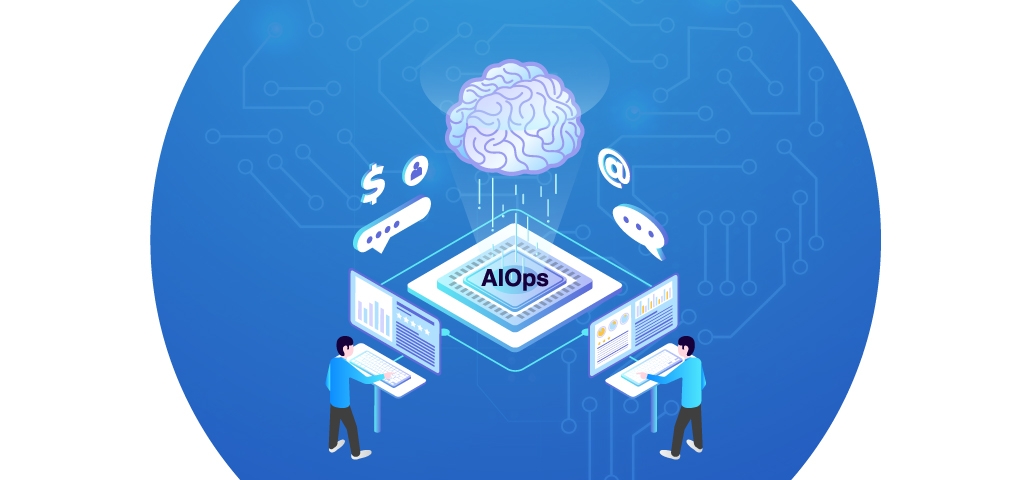
Table of Content
Artificial Intelligence for IT Operations (AIOps) is a technology that utilizes AI techniques to maintain, optimize and automate IT operations. It also uses multidisciplinary fields like machine learning and big data analytics. AI in IT operations monitors real-time data from your IT system and notifies you of any anomaly. You can adapt to situations quickly and resolve issues before they impact operations.
It is continuously learning from the data it is receiving and processing over time. It makes it more reliable and efficient in providing valuable actionable insights and makes IT management more smooth and easy. AIOps empowers businesses to handle increasing complexity by automating manual processes and offering proactive solutions. This helps organizations to reduce downtime, improve performance, and focus on strategic initiatives instead of routine maintenance.
Have you ever wondered why IT enterprises are adopting AI? It utilizes machine learning and big data analytics techniques, which have the ability to learn from previous data and forecast future issues. Businesses can take advantage of this ability and stay ahead of their competitors.
AIOps vs DevOps
Optimize Software Delivery Using Intelligent IT Operations
DevOps is a development practice that combines development and operations to deliver software faster using automated processes like CI/CD pipelines.
AIOps brings AI into the equation, helping teams monitor systems, detect anomalies, and resolve issues proactively—before they impact users. By integrating AIOps with DevOps, businesses can improve operational efficiency, enhance system reliability, and ultimately deliver a better user experience.
Key Concepts in IT Operations and Management
ITOM (IT Operations Management)
ITOM focuses on managing and optimizing an organization's entire IT infrastructure. This includes monitor and manage system capacity, ensuring performance, and maintaining availability across networks and digital services. ITOM also plays a role in managing IT resources, network configurations, and security protocols. ITOM is a core component of the broader ITIL framework, helping organizations streamline their IT operations for better efficiency.
ITSM (IT Service Management)
ITSM centers on delivering IT services to customers and ensuring those services meet their needs effectively. It covers the full lifecycle of IT services—from design and development to deployment, support, and ongoing maintenance. ITSM ensures that IT services align with the organization’s objectives and deliver the best possible user experience.
AIOps (Artificial Intelligence for IT Operations)
AIOps solution integrates AI, machine learning, and data analytics to automate and enhance IT operations. By predicting potential service outages, identifying root causes of issues, and streamlining IT processes, AIOps significantly boosts operational efficiency. It combines the capabilities of ITOM, ITSM, and automation to help organizations proactively manage and optimize their IT environments.
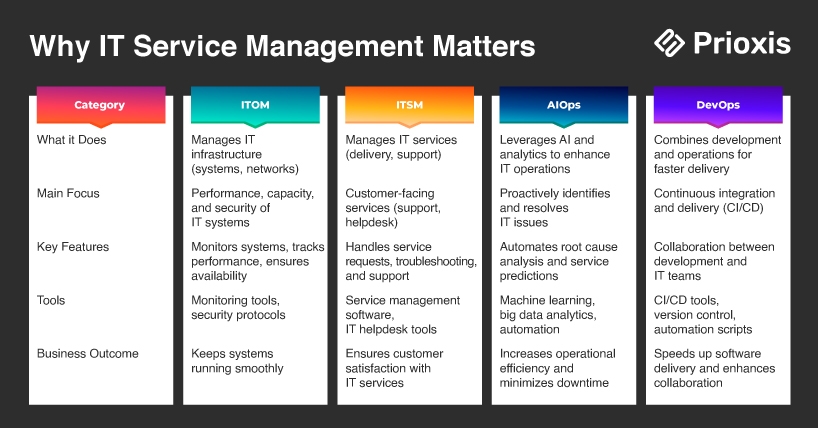
Why Choose AIOps for ITOps?
IT operations teams are facing growing challenges as they manage an increasing number of alerts, coordinate across multiple tools, and bridge the gap between cloud technologies and on-premises infrastructure. The pressure to maintain agility while ensuring stability is higher than ever.
To succeed in this environment, IT teams need a flexible, unified approach that ensures smooth operations across diverse technology environments. This is where AIOps comes in.
AIOps, short for Artificial Intelligence for IT Operations, offers a powerful solution to streamline IT management by:
- Cutting Through Alert Overload
AIOps reduces the noise of unnecessary alerts, allowing teams to focus on what truly matters.
- Automating Incident Response
By automating repetitive tasks, AIOps speeds up issue resolution and minimizes downtime.
- Integrating Tools Seamlessly
It connects the dots between different systems and tools, creating a more cohesive IT ecosystem.
- Enhancing Team Collaboration
It facilitates better collaboration between ITOps, DevOps, and site-reliability engineering (SRE) teams by providing a unified platform for incident management.
- Bridging Cloud and On-Premises Systems
AIOps helps IT teams manage both cloud-based and on-premises systems in a synchronized, efficient manner.
Leverage AIOps across technical, operational, and business processes, businesses can intelligently filter out false alarms, improve efficiency, and focus on core events. ITOps teams that adopt AIOps see faster, more reliable performance, with better decision-making and fewer disruptions.
How Does AIOps Works?
AIOps typically follows a multi-step process to optimize IT operations:
- Data Collection
AIOps gathers large volumes of data from various IT sources, such as logs, system metrics, and performance data. This diverse information forms the foundation for examine.
- Data Analysis
Machine learning algorithms are then applied to this data, identifying patterns, correlations, and anomalies. AIOps tools detect trends and root causes of problems, which traditional monitoring tools might miss.
- Automated Actions
Based on its anatomy, AIOps platforms can automate responses to IT issues. This might involve adjusting resource allocations, resolving performance bottlenecks, or even preemptively fixing potential system failures.
- Continuous Learning and Insights
AIOps doesn't just solve immediate problems; it learns from each interaction. Over time, it becomes better at predicting issues and providing more accurate, data-driven insights for improving overall IT operations. Reports deliver these insights, allowing IT leaders to make informed decisions.
The Benefits of AIOps for Your Business
AIOps (Artificial Intelligence for IT Operations) is transforming IT management by enabling teams to quickly identify and resolve issues. Here’s how AIOps can benefit your organization:
1. Reduced Mean Time to Repair (MTTR)
AIOps enhances your team's ability to reduce Mean Time to Repair (MTTR) by swiftly identifying the root causes of system slowdowns and outages. By analyzing data across various platforms, AIOps streamlines the troubleshooting process, allowing for quicker resolution and minimizing downtime.
2. Cost Efficiency
By automating the detection of operational issues and using predefined response protocols, AIOps lowers operational costs. This automation alleviates the burden on IT staff, enabling them to focus on strategic initiatives rather than routine monitoring. As a result, resources can be allocated more efficiently, improving overall organizational productivity.
3. Improved Team Collaboration
AIOps fosters better collaboration among different IT teams—such as DevOps, ITOps, and security—by providing a unified view of operational data. Enhanced visibility and communication facilitate faster decision-making, enabling teams to respond to incidents more effectively and work together seamlessly.
4. Proactive Operations Management
With its predictive analytics capabilities, AIOps continuously learns from operational data to highlight the most critical alerts. This foresight allows IT teams to address potential issues before they escalate into significant disruptions, reducing the likelihood of unexpected outages and ensuring smooth operations.
AIOps Use Cases
AIOps has three primary areas of application: business, technical, and operational. Each use case involves multiple stakeholders, ranging from IT teams to C-suite executives. However, the biggest impact is seen in business and operational areas, where AIOps deliver the most strategic value.
Business Use Cases
These focus on driving long-term improvements in IT service availability, fostering agility, and streamlining operations. AIOps allows companies to optimize their IT functions, leading to faster development cycles, reduced costs, and improved performance. For business leaders, this means gaining a competitive edge by delivering services more efficiently and adapting to market demands quicker.
Operational Use Cases
AIOps enhances operational efficiency by breaking down silos between teams, unifying tools, and creating a more integrated cloud architecture. By automating routine tasks and providing real-time visibility into system performance, AIOps enables IT operations to respond faster to issues and maintain smooth, uninterrupted service.
Business Use Cases
- Reduce downtime and improve service availability.
- Automate processes to optimize costs.
- Accelerate development and business agility.
- Ensure better performance and meet SLAs
Technical Use Cases
- Automate incident detection and resolution.
- Predict and prevent system failures.
- Enhance system monitoring with AI insights.
Operational Use Cases
- Unify teams, tools, and processes.
- Automate routine tasks for faster resolution.
- Optimize multi-cloud environments for efficiency.
These use cases not only improve the day-to-day technical and operational functions but also align with broader business goals, helping decision-makers enhance IT's contribution to overall organizational success.
Common Use Cases of AIOps
- Cross-Domain Engagement and Actionability
AIOps offers enterprise-wide visibility across multiple IT domains, allowing teams to predict potential issues, resolve them quickly, and maintain continuous service availability with a unified, platform-driven approach.
- Reducing Event Noise
AIOps helps IT teams filter out common spikes and low-impact events, focusing on the real issues causing system disruptions. This allows businesses to prioritize critical incidents and avoid getting overwhelmed by unnecessary alerts.
- Intelligent Anomaly Detection
By pulling data from the IT ecosystem, including third-party tools, AIOps can intelligently detect anomalies, filter irrelevant information, and trigger the right alerts or notifications to act promptly.
- Automating Incident Resolution
With continuous monitoring of infrastructure and service desk activities, AIOps enables automated responses to common IT issues. This automation speeds up resolution times, reduces manual intervention, and enhances system reliability.
- Root Cause Analysis Across Domains
AIOps uses advanced analytics to gather and analyze data from different parts of the IT environment—such as applications and infrastructure—helping teams pinpoint the root cause of issues faster and with greater accuracy.
- Capacity Optimization
AIOps provides insights into how resources are being used, helping businesses manage capacity more effectively. It identifies overused resources that need scaling and highlights idle resources that can be optimized, reducing waste and improving cost efficiency.
AIOps Use Cases for Driving Business Success
AIOps offers practical solutions for improving key business outcomes. It helps businesses tackle IT challenges by automating processes, optimizing costs, and enhancing system performance. Let’s explore four crucial AIOps use cases that provide clear value to business teams: reducing alert noise and IT workloads, cutting costs, boosting system performance, and increasing agility and development speed.
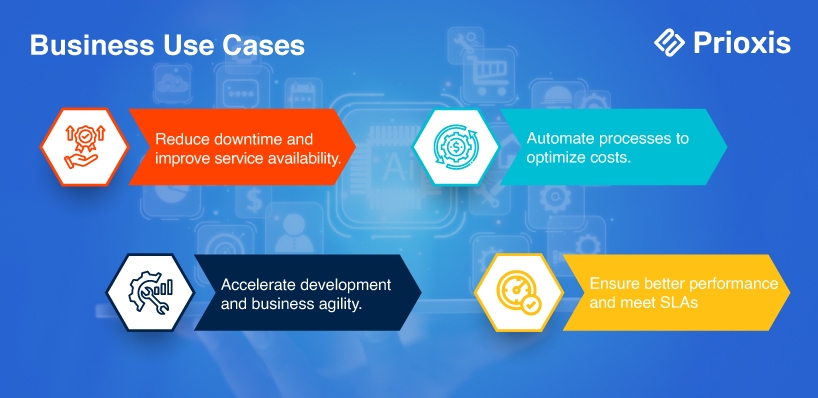
1. Reduce Alert Noise and IT Workloads
Managing alerts can overwhelm IT teams, but AIOps uses intelligent automation to significantly lower the volume of alerts and reduce workloads. By automating event correlation and responses, organizations can cut down alert volume by over 90%, allowing teams to manage growing data and incident volumes more efficiently.
Key Benefits Include:
- Automated Workflow
AIOps streamlines incident management by automating ticketing, notifications, and custom workflows. This ensures early detection of incidents, preventing costly service disruptions and SLA breaches.
- Enhanced L1 Support
With enriched data, Level 1 engineers can resolve more incidents without escalating to higher-level teams. This frees up specialized resources to focus on critical projects and reduces dependency on high-cost teams.
- Actionable Analytics
Productivity analytics helps leaders to monitor team performance, identify areas for optimization and best practice sharing, leading to better workforce management.
2. Optimize IT Spending
As organizations adopt more applications and services, resource consumption can spiral out of control. AIOps offers visibility and control over IT resources, helping businesses identify redundant tools and optimize spending. With AIOps, companies can fine-tune their toolsets to meet operational needs without overspending on unnecessary services.
Key Benefits Include:
- Cost Optimization
By identifying and eliminating redundant monitoring tools, AIOps helps reduce IT overhead without compromising incident management.
- Resource Efficiency
AIOps ensures businesses use their IT infrastructure effectively, balancing performance with cost-efficiency to deliver greater ROI.
3. Improve System Performance and Meet SLAs
Reliable IT infrastructure is critical for business success. Whether it’s maintaining profitability or ensuring customer satisfaction, technology performance directly impacts business outcomes. AIOps helps businesses maintain service availability and performance by rapidly addressing incidents and minimizing downtime.
Key Benefits Include:
- Faster Incident Resolution
AIOps reduces mean time to resolution (MTTR) by over 50%, allowing teams to swiftly address root causes and restore services.
- Optimized Performance
AIOps helps ITOps leaders meet performance objectives by proactively managing legacy tools and ensuring SLA compliance, resulting in reduced outages and uninterrupted customer transactions.
- Enhanced User Experience
With AIOps, businesses can provide a seamless customer experience by minimizing system failures and performance issues.
4. Accelerate Development and Boost Agility
For businesses pursuing digital transformation, managing incident overload and bottlenecks can be a significant barrier to growth. AIOps automates repetitive tasks, such as root-cause analysis and workflow management, freeing up teams to focus on innovation and business-critical projects.
Key Benefits Include:
- Empowered DevOps Teams
By automating routine tasks, AIOps allows L1 engineers to resolve more issues independently, enabling DevOps and Level 3 teams to concentrate on innovation.
- Support for Modern Architectures
AIOps integrates seamlessly with hybrid and cloud environments, helping businesses overcome challenges that traditional tools struggle with, particularly in modern architectures like microservices and containerization.
- Increased Business Agility
With faster incident resolution and automated workflows, AIOps helps businesses respond quickly to changing market conditions, driving agility and growth.
How AIOps Transforms Healthcare IT
Boosting Compliance and Operational Efficiency
- Securing Patient Data
AIOps ensures healthcare organizations meet regulatory standards like HIPAA by keeping patient information safe and reducing the risk of data breaches.
- Protecting Mobile Devices
AIOps helps healthcare providers secure mobile networks and devices, which are increasingly used by medical staff, minimizing security risks.
- Mitigating Cyber Threats
Healthcare organizations are common targets for cyberattacks. AIOps prevents ransomware and other threats, ensuring continuity and trust.
- Leveraging Data for Research
AIOps makes large volumes of patient data accessible, empowering healthcare leaders to make better research-driven decisions.
AIOps in Manufacturing IT
Reducing Downtime and Maximizing Production
- Automating Decision-Making
AIOps helps manufacturers make real-time decisions by analyzing data from supply chains and production, improving efficiency.
- Enhancing Factory Performance
AIOps provides real-time monitoring of machines, offering insights to business owners about production cycles, quality control, and operational efficiency.
- Avoiding Costly Downtime
AIOps uses predictive maintenance to foresee machine breakdowns, helping manufacturers avoid costly disruptions and maintain revenue streams.
- Streamlining Supply Chains
Manufacturers can improve supply chain management by leveraging AIOps to predict inventory needs and minimize delays.
Financial Services IT
How AIOps Secures Data and Enhances Customer Experiences
- Strengthening Cybersecurity
AIOps protect financial institutions by identifying and preventing sophisticated cyber threats before they can harm operations.
- Improving Customer Insights
Business owners can use AIOps to better understand customer behavior, allowing for more personalized services and targeted marketing.
- Driving Financial Forecasting
AIOps helps financial leaders make accurate revenue predictions by analyzing historical data, supporting long-term business planning.
- Maintaining Compliance
AIOps ensures financial institutions meet regulatory requirements by continuously monitoring systems and data, reducing legal risks.
AIOps in Retail IT
Optimizing Operations and Delivering Personalized Experiences
- Boosting Customer Engagement
AIOps helps retail businesses analyze customer data in real time, offering tailored shopping experiences that increase sales and loyalty.
- Maximizing Inventory Efficiency
Business owners can rely on AIOps to predict demand, streamline inventory management, and prevent overstock or stock-out issues.
- Minimizing System Disruptions
AIOps ensures smooth retail operations by identifying potential system failures before they happen, improving customer satisfaction.
- Securing Online Transactions
AIOps helps retailers detect and prevent fraud, ensuring that online payment systems are secure and trustworthy for customers.
AIOps in Education IT
Seamless Operations and Protecting User Data
- Maintaining Learning Platform Uptime
AIOps monitors virtual classroom systems to ensure educators and students experience no downtime, supporting business continuity.
- Securing Sensitive Student Information
Education leaders can use AIOps to protect student data from breaches, ensuring compliance with data protection regulations.
- Enhancing Educational Outcomes
By analyzing performance data, AIOps helps educators tailor learning experiences to improve student success, benefiting educational institutions.
Wrapping Up
AIOps is a powerful tool for any business looking to make data work harder and smarter. It improves security, makes operations smoother, and drives productivity—key factors for growth. At Prioxis, we’re transforming IT Operations with AIOps. Implementing AIOps can transform conventional IT operational frameworks, break down silos, and enhance processes with reduced reliance on human involvement. Reach out to us for a custom demonstration, so you can justify investment in AIOps.
Get in touch

